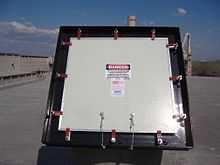Explosion vent

An explosion vent or rupture panel[1][2] is a safety device to protect equipment or buildings against excessive internal, explosion-incurred pressures, by means of pressure relief. An explosion vent will relieve pressure from the instant its opening (or activation) pressure pstat has been exceeded.
Several explosion vent panels can be installed on the same process vessel to be protected. Explosion vents are available in the versions self-destructive, non-self-re-closing and re-usable, self-re-closing.

Explosion vent construction must balance the contradictory requirements "low inertia" and "high strength". Inertia negatively affects an explosion vent's efficiency. High strength is required to endure the considerable forces that move the vent's venting element in order to open the venting orifice. Unintended disintegration must not cause disintegrating parts turning into a missile.

The evaluation of an explosion vent's efficiency and its range of application are subject to rules. See National Fire Protection Association 68, EN 14797.
During normal venting, the explosion is freely discharged, allowing flames to exit the process being protected. When the protected vessel or pipe is located indoors, ducts are generally used to safely convey the explosion outside the building. However, ductwork has disadvantages and may result in decreased venting efficiency. Flameless venting, in combination with explosion vents, can extinguish the flame from the vented explosion without the use of expensive ducting, limitations to equipment location, or more costly explosion protection.
See also
- Rupture disc
- Blast damper
- Dust explosion
- Pressure relief valve
- Explosion protection
- Explosion pressure
- Explosives safety
- Prestressed structure
- Inert gas
- Electrical equipment in hazardous areas
References
- ↑ "US Patent # 6,367,203. Rupture panel". Patents.com. Retrieved 2013-12-22.
- ↑ "Rupture panel (патент US № 8322360)". Freepatent.ru. Retrieved 2013-12-22.